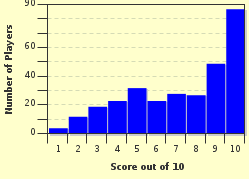Quiz Answer Key and Fun Facts
1. To understand Maxwell's equations, we'll first have to review a bit of math so that we know what we're looking at. All four equations have to do with properties of the electric and magnetic field vectors. Which of these best describes a vector?
2. Next, we'll need the mathematical concept of divergence, which comes from vector calculus. Picture a vector function, which associates every point in space with its own vector; electric and magnetic fields are two of the things described this way. If you calculate the divergence of a vector function, what are you measuring?
3. Our next concept is simple but very useful: flux. Here, we're worried about the flux of a field - electric or magnetic. If you want to calculate the flux of an electric field, you'd do it by finding the surface integral of the electric field. In simpler terms, what are you computing?
4. We're ready now for the first of Maxwell's equations: Gauss's law. This law says that the divergence of the electric field is proportional to the charge density. What does the law say about the flux of the electric field through an enclosed volume?
5. The simplest of Maxwell's equations -- the second one -- has no name, though it does have big implications. The divergence of the magnetic field, according to this law, is equal to zero. In less abstract terms, what does this mean?
6. For the second pair of Maxwell's equations, we need another concept from vector calculus: curl. If you compute the curl of a vector function (which, remember, assigns a vector to each point in space), just what is it that you're calculating?
7. Ampère's law, as originally formulated, isn't *exactly* right -- but in the static case, where currents are steady, it works just fine. On one side of the equation, we have an electrical current density J, multiplied by a constant (the permeability of free space) to make the units work out. This is all equal to the curl of what vector quantity?
8. What happens when fields start changing? Michael Faraday had one answer, and Faraday's law is now the third of Maxwell's equations. According to this law, the rate of change of the magnetic field is equal to -1 times the curl of the electric field. What's another way to describe this behavior?
9. At last, we come to the father of classical electrodynamics: James Clerk Maxwell (1831-1879). He spied a problem with Ampère's law: the original equation suffers from a mathematical inconsistency when currents are allowed to change in time. Maxwell fixed the inconsistency by adding another term, which he called the "displacement current," to the current-density term. On what does Maxwell's "displacement current" depend?
10. Let's consider the quartet of Maxwell's equations in a vacuum where there's no charge and no current. In the language of calculus, they're a set of coupled differential equations for the electric and magnetic fields E and B. If you know the right tricks, you can manipulate them into two decoupled differential equations: one for E, and one for B. Each one looks just like a wave equation. How fast are the waves moving?
Source: Author
CellarDoor
This quiz was reviewed by FunTrivia editor
gtho4 before going online.
Any errors found in FunTrivia content are routinely corrected through our feedback system.

